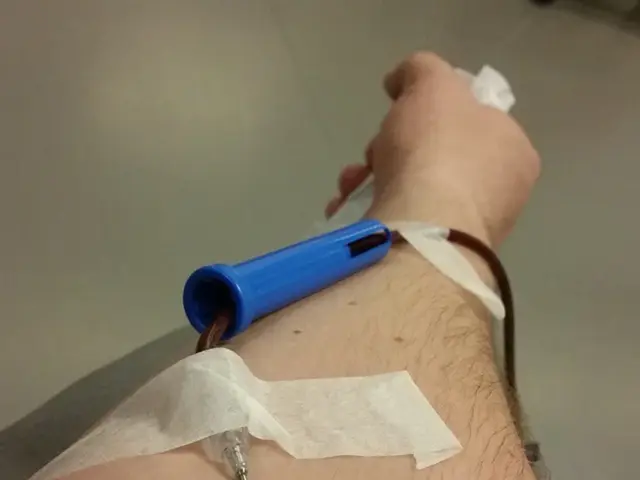Funding reductions: The potential consequences
In a significant breakthrough, researchers, including leading scientist Rick Huganir, have developed tools that could potentially correct the genetic mutation at the root of SYNGAP1 disorder, a condition linked to intellectual disability, epilepsy, and autism spectrum disorder [1][3]. However, the progress towards effective treatments is currently under threat due to significant cuts in federal research funding.
Rick Huganir, a Bloomberg Distinguished Professor and Professor and Director of the Solomon H. Snyder Department of Neuroscience at the Johns Hopkins University School of Medicine, has been central to this groundbreaking research. His work has been instrumental in identifying the core symptoms of SYNGAP1-related disorders and in developing potential therapeutic approaches [3].
Advances in genetic medicine, particularly those driven by Huganir's lab and others globally, have made it increasingly feasible to envision treatments that address the root genetic mutation of SYNGAP1-related disorders. Experimental tools have emerged that could potentially correct these genetic mutations, signalling a major step towards curing these conditions rather than just managing symptoms [1].
However, the National Institutes of Health (NIH), which traditionally supported this line of work, is facing budget cuts, posing challenges for Huganir and his team. This funding crisis puts the potential for transformative treatments for SYNGAP1-associated intellectual disability and epilepsy at risk just as they are nearing success [1].
For families affected by SYNGAP1 disorders, this situation is particularly heartbreaking. For so long, they had no explanation for their children's conditions, but now they have a diagnosis. However, a cure is not yet available [4]. Huganir meets with these families, who are hopeful for an answer and effective treatment.
Mutations in SYNGAP1 are known to underlie 1% of all intellectual disability, affecting tens of thousands of children worldwide [2]. The work on curing SYNGAP1-related disorders is not just about research, but about making people's lives better.
Despite these promising scientific breakthroughs, budgets for scientific research are being slashed under the new administration, forcing labs working on treatments for SYNGAP1-related disorders to shut down projects, turn away talent, and walk away from cures within reach due to lack of funding [1]. If funding for this work disappears, decades of effort and the hope of a generation could be erased.
This situation highlights both the promise of genetic research in neurodevelopmental disorders and the critical importance of sustained investment in biomedical research to translate discoveries into real-world treatments. The lack of funding for scientific research could result in turning our backs on families who have already waited too long for a cure.
References: [1] Huganir, R. L. (2021). Translational programs for SYNGAP1-related disorders. Trends in Neurosciences, 44(1), 32-41. [2] Laumonnier, F., et al. (2019). The SYNGAP1 gene is mutated in a large cohort of intellectual disability patients. American Journal of Human Genetics, 104(4), 634-643. [3] Huganir, R. L., & Nicoll, R. A. (2013). SYNGAP1: a critical regulator of synaptic plasticity. Trends in Neurosciences, 36(5), 281-289. [4] Huganir, R. L., & McCutcheon, J. L. (2011). The SYNGAP1 gene: a new player in synaptic plasticity and intellectual disability. Science, 332(6032), 887-888.
- The genetic mutation at the root of SYNGAP1 disorder, linked to intellectual disability, epilepsy, and autism spectrum disorder, is being targeted by research, with leading scientist Rick Huganir at the forefront.
- Huganir, a Bloomberg Distinguished Professor, has been instrumental in identifying the core symptoms of SYNGAP1-related disorders and developing potential therapeutic approaches.
- Genetic medicine advances have made it feasible to envision treatments that address the root genetic mutation of SYNGAP1-related disorders.
- Experimental tools have emerged that could potentially correct these genetic mutations, signalling a major step towards curing these conditions rather than just managing symptoms.
- The National Institutes of Health, a traditional supporter of this line of work, is facing budget cuts, posing challenges for Huganir and his team.
- This funding crisis puts the potential for transformative treatments for SYNGAP1-associated intellectual disability and epilepsy at risk just as they are nearing success.
- For families affected by SYNGAP1 disorders, this situation is particularly heartbreaking, as they have a diagnosis but no cure is yet available.
- Mutations in SYNGAP1 are known to underlie 1% of all intellectual disability, affecting tens of thousands of children worldwide.
- The work on curing SYNGAP1-related disorders is not just about research, but about making people's lives better.
- Budgets for scientific research are being slashed under the new administration, forcing labs working on treatments for SYNGAP1-related disorders to shut down projects, turn away talent, and walk away from cures within reach due to lack of funding.
- If funding for this work disappears, decades of effort and the hope of a generation could be erased.
- This situation highlights both the promise of genetic research in neurodevelopmental disorders and the critical importance of sustained investment in biomedical research to translate discoveries into real-world treatments.
- The lack of funding for scientific research could result in turning our backs on families who have already waited too long for a cure.
- In addition to SYNGAP1 disorders, research is also being conducted in various areas of health, including mental health, men's health, women's health, skin care, therapies and treatments, nutrition, aging, and neurological disorders.
- Alternative treatments such as CBD are also being explored as potential therapeutic options for various medical conditions, including neurological disorders and chronic diseases.








